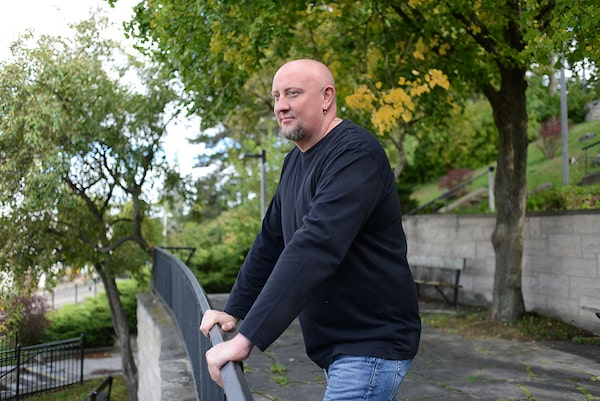
After suffering a knee injury, chiropractic care helped Leroy Gallagher return to work as an electrician.IAN M. STEWART/THE GLOBE AND MAIL
Seven years ago, a knee injury started a domino effect in Leroy Gallagher’s body that would leave him off work for years.
“It happened back in 2011,” recalls the 36-year-old electrician from Cambridge, Ont. “I busted up my knee and after that I ended up with severe problems in my back and my neck. I’d been doing construction for a long time, but I wasn’t able to work.”
It was a dark time for Gallagher, who says being out of work “puts a strain on your relationships and you sort of lose your purpose.”
It wasn’t a choice for him to stop working, but his body just couldn’t continue with the back and neck pain he was in and the strain his labour-intensive job involved.
“I just couldn't do it, I couldn't work,” adds Gallagher.
In fact, low back and neck pain are the leading causes of disability in Canada, according to the Institute for Health Metrics and Evaluation. Back pain is also the main reason for physician visits in patients under 60 in Canada, according to researchers at Université du Québec. Back pain impacts 84 per cent of the working population at some point in their lives. According to a 2017 report by Ontario’s Workplace Safety and Insurance Board (WSIB), over the past 10 years, the lower back has consistently represented the leading part of the body injured among Ontario WSIB recipients.
While Gallagher is back at work, many people are forced into unemployment due to these musculoskeletal (MSK) low-back injuries and conditions. Made up of bones, ligaments, joints and tendons, the MSK system accounts for the majority of work-related lost-time claims in Canada, with significant physical, emotional and financial impacts on patients, government and employers.
A 2009 report from the Work Foundation at Lancaster University found that MSK disorders remain the number one cause of work-related lost-time claims in Canada. The report also estimates the cost to Canadian workplaces from lost productivity and absenteeism to be in the “hundreds of millions of dollars.”
But there are ways, like chiropractic care, that are proven to get people back to work faster.
“There is an incredible cost associated with these injuries,” explains Dr. Amy Brown, a chiropractor in Cambridge. “It’s not just the cost to the patient, which can be significant, but it’s the cost of maintaining people in the health care system and the cost to employers. It's a cascade effect.”
After years of treating patients who were off work with MSK-related pain and injury, Dr. Brown decided to lend her services outside her clinic to try and help others get back to work.
Twice a week, Dr. Brown and her colleagues, Dr. Cameron Potter and Dr. Douglas Cameron, volunteer at Langs Community Health Centre in Cambridge. The team provides chiropractic care, free of charge, to patients who cannot afford it, many of whom are off work due to MSK issues. Our goal is “to get patients feeling better and back to work as quickly as possible,” says Dr. Brown.
“When we first started, we saw patients with a lot of other health issues going on. We were seeing some really long-term problems that hadn’t been addressed and many patients were not employed because of ongoing injuries,” she adds.
But those who seek help from chiropractors, such as Drs. Brown, Potter and Cameron, have experienced positive results, including Gallagher.
“I’m back doing work as an electrician,” he says. “And not long ago, I could barely get off the floor.”
Indeed, Gallagher credits his chiropractic sessions and a new love of yoga with getting him back on his feet — literally. “It really helps with my mobility and stiffness,” he adds.
For him, it was about getting back to work, and also about getting his quality of life back. “When you’re not working, you can fall into the mental trap of getting down on yourself,” he recounts. “But I’m able to work and I’m able to manage.”
How muscle and joint conditions impact the workplace
- Back and neck pain are among the top three drivers for both short-term and long-term disability claims in Canada, according to the Institute for Health Metrics and Evaluation’s 2016 report.
- A 2017 report by Ontario’s Workplace Safety and Insurance Board (WSIB) indicates that strains and sprains represented 44 per cent of allowed lost-time claims in the province last year.
- According to Ontario’s Public Services Health and Safety Association (PSHSA), musculoskeletal disorders have consistently been the leading type of work injury in the province over the past 10 years.
- A 2018 report by the Bone and Joint Initiative USA indicates that back pain alone accounted for 264 million lost work days in the United States in one year.
Advertising feature produced by Globe Content Studio. The Globe’s editorial department was not involved.